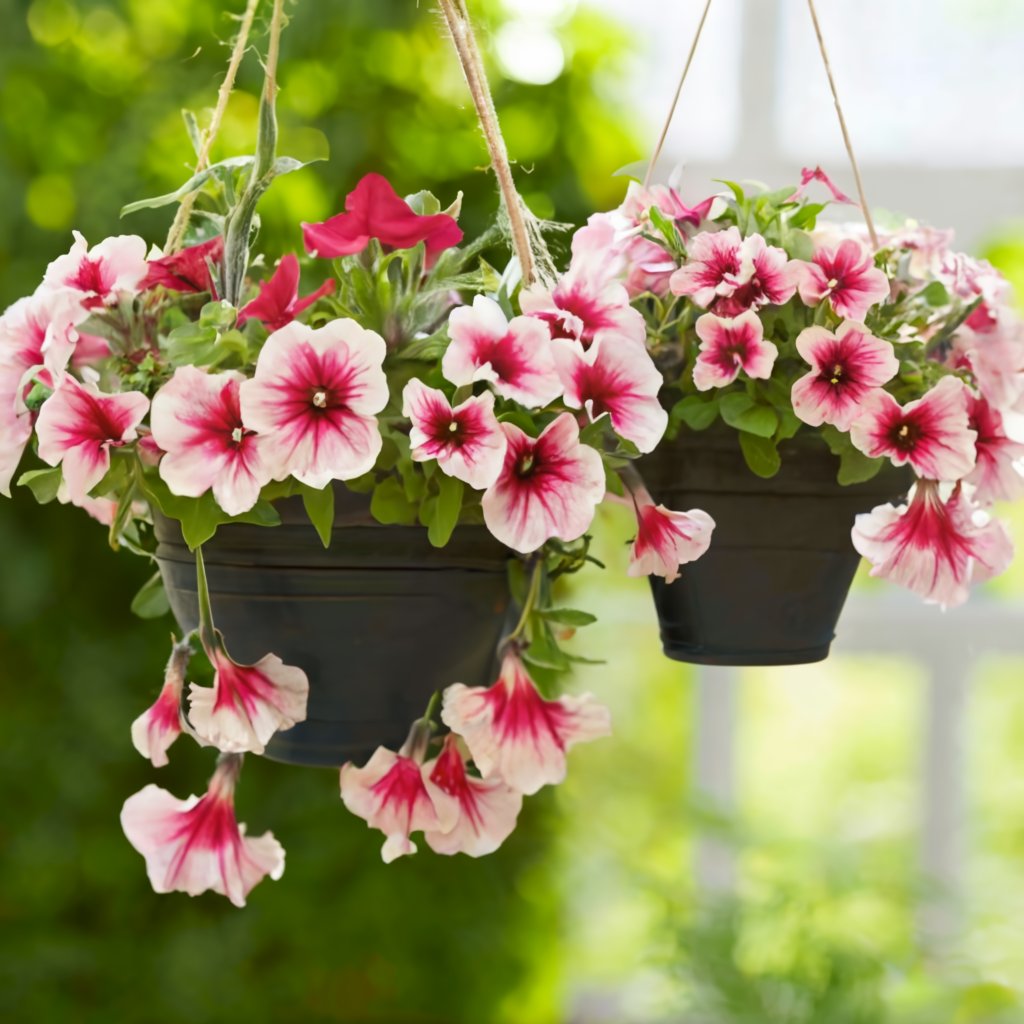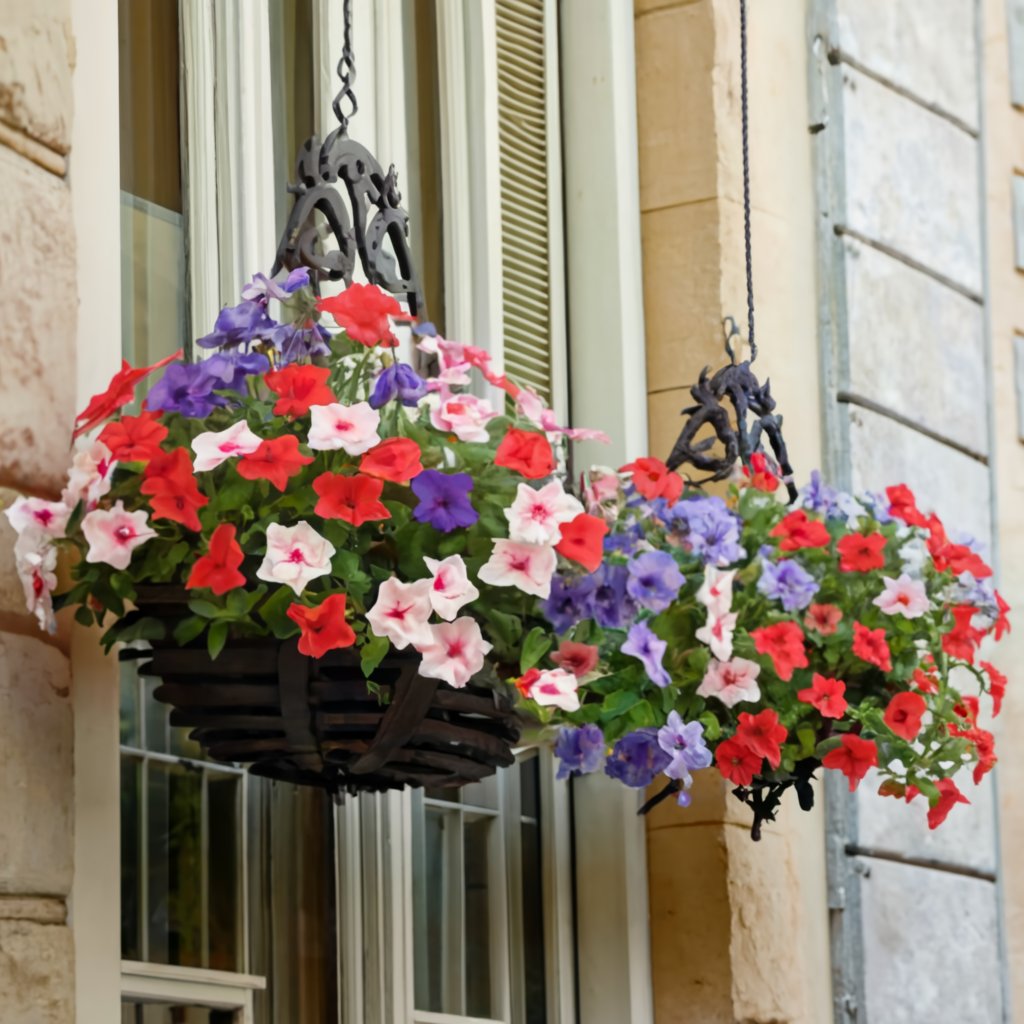
This post may have affiliate links. This means that sometimes when you click a link on our site and make a purchase on Amazon, we may earn a small commission at no additional cost to you. We only recommend products we truly believe in, and your support helps keep us running!
Imagine vibrant blooms cascading down from overflowing hanging baskets, a symphony of color gracing your porch or patio all summer. Petunias, with their cheerful trumpet-shaped flowers and low-maintenance needs, are the perfect candidates for creating this dazzling display. But how do you keep these beauties blooming nonstop throughout the hottest months? Fear not, fellow gardening enthusiasts! This guide unveils the secrets to effortless petunia care in hanging baskets, ensuring a season filled with floral fireworks.
Location, Location, Location: Sunshine is Key
Petunias are sun worshippers. To thrive and produce a continuous stream of blooms, they crave a minimum of six hours of direct sunlight daily. Ideally, aim for eight hours or more. When selecting a location for your hanging baskets, prioritize areas bathed in sunshine throughout the day. South-facing walls or sunny corners of your porch are prime real estate for your petunia paradise.
Morning Sun vs. Afternoon Sun: Does it Matter?
While petunias love sunlight, scorching afternoon heat can sometimes be a bit harsh. If your chosen location receives full sun only in the afternoon, opt for varieties bred for heat tolerance, like the aptly named ‘Wave’ petunias. Alternatively, consider hanging your baskets in areas with dappled sunlight during the hottest part of the day.
Watering Wisely: Keeping the Soil Moist but Not Soggy
Hanging baskets tend to dry out faster than container plants on the ground. The key to keeping your petunias happy is consistent moisture without drowning them. Here’s how to strike the perfect balance:
- The Finger Test: Stick your finger into the soil about an inch deep. If it feels dry, it’s watering time!
- The Weight Test: Lightweight baskets usually indicate thirsty plants. Lift the basket to gauge its weight. When it feels significantly lighter, watering is needed.
- Daily Check-Ins: Especially during hot weather, check on your petunias daily. Aim for the soil to be consistently moist, but not soggy. Water deeply until water runs out the drainage holes. This ensures the entire root system gets a good drink.
Pro Tip: Grouping Power
Grouping hanging baskets with similar water needs close together can help retain moisture. The plants create a microclimate, reducing evaporation from the soil.
Feed Me! Nourishing Your Petunias for Continuous Blooms

Petunias are prolific bloomers, and all that flower power requires a steady supply of nutrients. Here’s how to keep your petunias well-fed:
- Slow and Steady Wins the Race: When planting, incorporate a slow-release fertilizer into the potting mix. This provides a continuous supply of nutrients over time.
- Liquid Love: During the peak flowering season (usually from late spring to early fall), supplement with a water-soluble fertilizer every two to three weeks. Opt for a balanced fertilizer formulated for flowering plants.
Less is More: Avoiding Fertilizer Overload
While fertilizer is essential, overdoing it can harm your petunias. Signs of fertilizer burn include yellowing leaves and stunted growth. If you notice these symptoms, flush out the soil with plain water for a few watering sessions.
Deadheading for Dazzling Displays
Deadheading, the simple act of removing spent flowers, is a game-changer for petunia performance. Here’s why:
- More Blooms, Less Stress: Removing spent flowers encourages the plant to put its energy into producing new blooms, rather than wasting it on seed production.
- Aesthetics Matter: Deadheading keeps your petunias looking neat and tidy, allowing the vibrant new flowers to take center stage.
How to Deadhead Like a Pro
- Use sharp pruners or your fingers to pinch off the spent flower head just below the calyx (the green base that holds the flower).
- Aim to remove the stem a quarter-inch down from the wilted flower.
- Don’t be afraid to prune! Regular deadheading throughout the season will promote bushier growth and even more blooms.
Bonus Tip: A Haircut for a Healthier Plant
An occasional haircut can work wonders for your petunias. Here’s when and how to prune:
- Leggy Looks? If your petunias become leggy with fewer flowers towards the top, a light trim can encourage bushier growth.
- Pinch and Shape: Gently pinch off the top inch or two of growing stems to promote branching and a fuller appearance.
- When to Take the Shears: Prune lightly throughout the growing season, but avoid major cuts during the hottest months of summer.
